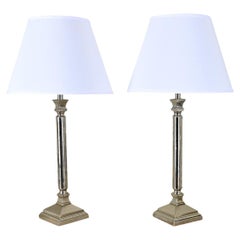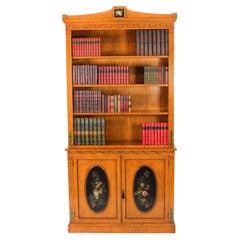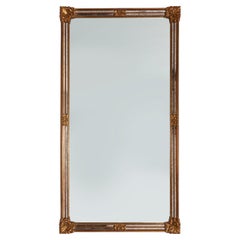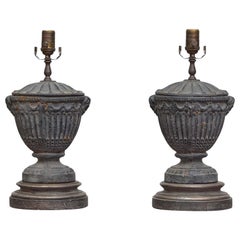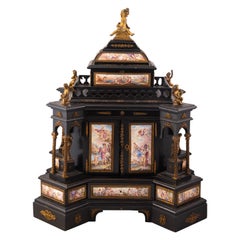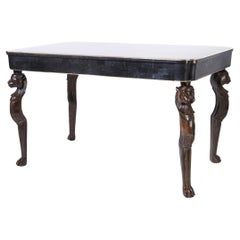Revival Furniture
to
1,342
3,351
2,864
6,139
550
72
197,299
114,769
44,112
33,015
16,200
12,150
10,904
10,825
9,960
8,924
7,341
6,629
6,524
6,396
6,198
6,127
4,924
3,750
141
2,959
3,039
622
1,097
950
457
180
42
147
97
99
161
135
161
67
54
3,062
2,764
924
914
827
4,967
1,610
1,413
738
600
6,761
6,569
6,655
266
51
24
21
21
Style: Revival
Pair of French Vintage Silvered Table Lamps
Located in Baton Rouge, LA
A vintage pair of tall table lamps are sure to elevate your interior with class, style, and light. Designed in a Neoclassical column form of silver-tone metal with square pedestal ba...
Category
20th Century French Revival Furniture
Materials
Metal
$1,795 / set
Vintage English Sheraton Revival Satin Wood Open Bookcase 20th Century
Located in London, GB
This is a beautiful antique Sheraton Revival top quality open bookcase, masterfully crafted in rich satin wood with handpainted floral decoration, dating from the mid 20th Century.
...
Category
Mid-20th Century English Revival Furniture
Materials
Satinwood
Large 20th century rectangle gilded Deknudt mirror in Baroque style, Belgium
By Deknudt
Located in Meulebeke, BE
Belgium / 1980 / Mirror / DeKnudt / Resin, wood / Mid-century / Baroque
Beautiful and very large rectangle gilded Deknudt mirror. This mirror features a baroque style frame with mar...
Category
1980s Belgian Vintage Revival Furniture
Materials
Mirror, Resin, Wood
Pair of English 19th Century Lead Urn Table Lamps with Classical Motifs, Wired
Located in Atlanta, GA
A handsome pair of English 19th-century lead urns, now converted into table lamps and elevated on later wooden plinths. Rich in neoclassical detail, each urn features a fluted balust...
Category
19th Century English Antique Revival Furniture
Materials
Lead
Viennese tabletop jewelry box or chest. Austria, 19th century.
Located in Madrid, ES
Viennese tabletop jewelry box or chest. Wood, enamels, bronze. Austria, second half of the 19th century.
Requires restoration.
Rectangular table...
Category
19th Century Austrian Antique Revival Furniture
Materials
Bronze, Enamel, Other
Maitland-Smith Vintage Egyptian Style Writing Desk
Located in Palm Beach, FL
Standout mid century writing desk having a tessellated marble top on a case with two drawers and brass borders over four dramatic bronze Egyptian style cat legs. Signed Maitland-Smit...
Category
20th Century Philippine Revival Furniture
Materials
Marble, Brass
Rare Antique Gothic Revival Medieval / Chimera Sculpture Wall Bracket or Shelf
Located in Lisse, NL
Stunning and deeply carved nutwood, Gothic Art wall bracket, Corbel.
If you are a collector of rare and striking Gothic antiques then this bracket could be the perfect addition to your collection. This all handcrafted and marvelously hand carved, 19th century wall bracket is a work or art in its own right. It depicts a medieval figure...
Category
Mid-19th Century French Antique Revival Furniture
Materials
Metal
Set of 3 Sèvres Porcelain Cups & Saucers “Marie-Antoinette”, c.1900
Located in CANNES, FR
A rare and refined set of three porcelain cups and saucers from the prestigious Sèvres manufactory, dating to around 1900. Decorated in the iconic “Marie-Antoinette” pattern, this se...
Category
Early 20th Century French Revival Furniture
Materials
Porcelain
Iron strong box or safe. 19th century
Located in Madrid, ES
Safe box. Iron. XIX century.
Rectangular safe made of iron, with a rectangular base, two handles on the sides and classicist-influenced molding decorations on the fronts and top. It...
Category
19th Century European Antique Revival Furniture
Materials
Other, Iron
Vintage Neoclassical Iron Four Poster Bed Maitland Smith
Located in W Allenhurst, NJ
Wonderful Iron Neoclassical four poster bed. 3 dimensional Laurel Wreath centers the headboard and four posts are topped with brass accent and cascading vines. Brass ball feet and ac...
Category
Mid-20th Century Revival Furniture
Materials
Brass, Iron
Antique French Wrought Iron Fireplace Screen - Hand-Forged Gothic Revival
Located in Raleigh, NC
This exceptional hand-forged wrought iron fireplace screen showcases the masterful craftsmanship of French metalworkers. Featuring intricate gothic scroll patterns that dance across ...
Category
1890s Antique Revival Furniture
Materials
Wrought Iron
Canakkale Turkish Ottoman Revival Treacle Glazed Duck Ewer
Located in Bishop's Stortford, Hertfordshire
A rare and fine Turkish, Ottoman revival, Canakkale treacle glazed duck ewer dating from the 19th century. Lightly hand potted in a dark, probably terracotta clay the ewer is formed ...
Category
19th Century Turkish Antique Revival Furniture
Materials
Terracotta
Unique Large and Great Quality Gothic Revival Solid Bronze Two-Light Wall Sconce
Located in Lisse, NL
Unique Gothic Revival light fixture for wall mounting.
This antique Gothic wall sconce with two flowery glass shades is another one of t...
Category
Late 19th Century French Antique Revival Furniture
Materials
Brass, Bronze
Antique Italian Carved Walnut Renaissance Revival Library Serving Table, 1870
Located in Portland, OR
A very good antique Italian, Renaissance Revival carved walnut library/serving table, circa 1870.
The table top having a carved gadrooned edge with substantial carved supports at each end, the ends having incised carved decoration and acanthus leaf brackets, the table is raised on large carved lion's paw feet.
Condition is very good.
Bloomsbury Fine Art...
Category
1870s Italian Antique Revival Furniture
Materials
Walnut
$2,636 Sale Price
20% Off
Modernist Aubusson Rug in the Neo Baroque Style Signed JF
By André Arbus
Located in Milan, IT
One of the main trajectories of French Modernism was dedicated towards a revival of a classical iconography. Motivated from a reaction towards the often rigid and austere mood of the...
Category
1930s French Vintage Revival Furniture
Materials
Wool
Wrought Iron Garden Bench, Periwinkle
Located in Stamford, CT
Charming baroque style wrought iron bench painted periwinkle. Lattice iron seat for three with three lattice ovals on the back. Eight legs, two curvy arms. Arm height: 26". Perfect i...
Category
1970s American Vintage Revival Furniture
Materials
Wrought Iron
Faux Bamboo Blue Painted Four Drawer Chest of Drawers
Located in Haddonfield, NJ
Lots of detail on this sturdy chest of drawers. This four drawer faux bamboo chest has been painted in a Gustavian shade of blue. Very versatile piece that could be used in a living ...
Category
Early 2000s European Revival Furniture
Materials
Metal
$1,160 Sale Price
20% Off
Antique and Strong & Heavy Oak Gothic Revival Stool, Pedestal Stand or End Table
Located in Lisse, NL
Truly medieval looking, antique sculptural stool or table in the Gothic Style.
Thanks to its honest wear of having been used for well over a century, this Gothic Revival stool very ...
Category
Early 19th Century European Antique Revival Furniture
Materials
Oak
Baker Furniture Egyptian Revival Rosewood Leather Top Executive Bureau Plat Desk
Located in South Bend, IN
A gorgeous Egyptian Revival, Neoclassical, or Empire style executive writing desk or bureau plat desk
By Baker Furniture
USA, Late 20th Century
Rosewood, with embossed leather top...
Category
Late 20th Century American Revival Furniture
Materials
Brass
Vintage Tudor Gothic Revival Style Arm Chair with Intricate Carvings
Located in Seattle, WA
The vintage chair is crafted from dark wood with a Gothic Revival style, evident in its intricate carvings, including circular cutouts, swirling patterns, and a diamond-shaped inlay ...
Category
1970s Vintage Revival Furniture
Materials
Wood
Spanish Manises Large Porcelain Lidded Urn by Hispania/ Lladró, 1970s
By Lladro, Hispania CH
Located in Valencia, VC
An impressive extra-large Rococo Revival lidded urn, handcrafted in the 1970s by CH Hispania of Manises, Spain—a renowned maker that was later absorbed into the world-famous Lladró p...
Category
1970s Spanish Vintage Revival Furniture
Materials
Ceramic, Clay, Porcelain, Stoneware
$557 Sale Price
50% Off
Awesome Antique Bronze Gothic Revival 9 Light Chandelier with Phoenix Sculpture
Located in Lisse, NL
Handcrafted and truly impressive Neo-Gothic Church fixture that can also be used for candles.
Over the decades we have sold a number of very good antique bronze, Gothic light fixtures for both candles and electrical bulbs. However, we never offered one as high and with as many Gothic details as this hand-crafted chandelier. You will rarely come across a Gothic work of religious art that is more elaborate and with as many Gothic details as this fit-for-a-castle pendant...
Category
Late 19th Century French Antique Revival Furniture
Materials
Gold, Bronze
Late 20th Century/C. 1970 Silvered Napoleon Empereur Letter Opener by Christofle
By Christofle
Located in North Miami, FL
Late 20th century/circa 1970 silvered Napoleon Empereur letter opener by Christofle
By: Christofle
Material: silver, silver plate, metal, paper
Technique: polished, silvered, metalw...
Category
Late 20th Century French Revival Furniture
Materials
Silver, Silver Plate, Metal
Rare Egyptian Revival Carved and Inlaid Rosewood Loveseat
Located in Buffalo, NY
Egyptian Revival loveseat composed of hardwood inlaid with bone,ebony, Upholstered in a very rare felt hand stitched applique fabric in Egyptian motif,,original,The loveseat features reversable back...
Category
1880s Egyptian Antique Revival Furniture
Materials
Fabric, Bone, Hardwood, Ebony
Stone Neoclassical Bust Garden Sculpture
Located in Nantucket, MA
Vintage Stone Neoclassical Bust Garden Sculpture, circa 1920s, a hand sculpted stone dust or cement ancient Grecian style "archeological" bust of Venus-Aphrodite. Found in old garden...
Category
Early 20th Century American Revival Furniture
Materials
Cement
19th Century French Gothic Revival Chair
Located in Dallas, TX
19th Century French Gothic Revival chair is a wonderful testament to the craftsmen of a bygone era! Hand-sculpted from old growth oak, it feature...
Category
Mid-19th Century French Antique Revival Furniture
Materials
Oak
Stunning Pair of 7-candle Gothic Revival Brass Candelabra
Located in Leesburg, VA
Stunning Pair of 7-candle Gothic Revival Brass Candelabra
Anonymous
Europe; 19th century
Brass or bronze
Approximate size: 13 (h) x 21 (w) x 4 (d) in.
This pair of European bras...
Category
Late 19th Century Belgian Antique Revival Furniture
Materials
Brass
Italian Alabaster Bust of a Young Woman, Possibly Saint Catherine of Siena c1890
Located in Lisse, NL
Museum quality sculpture of a serene possibly Saint Catherine of Siena.
This exquisite Italian alabaster bust, carved circa 1890 and set upon a dark, polished marble base, emanates ...
Category
Late 19th Century Belgian Antique Revival Furniture
Materials
Alabaster, Marble
Pair of Tall Gilded Figural Marble Top Neoclassical French End Tables
Located in Swedesboro, NJ
This striking pair of French Neoclassical end tables embodies timeless elegance and sculptural refinement. Each table features a tall, finely cast gilded bronze female figure, draped...
Category
1940s French Vintage Revival Furniture
Materials
Composition, Marble
1900s French Gothic Revival Painted Cabinet with Arched and Quatrefoil Motifs
Located in High Point, NC
This 1900s French Gothic Revival painted cabinet features striking architectural motifs that echo the grandeur of medieval design. The front panels display tall arched forms above a ...
Category
Early 20th Century French Revival Furniture
Materials
Wood
A Set of 4 Victorian Barley Twist Oak Dining Chairs This is a lovely set
Located in Godshill, Isle of Wight
A Set of 4 Victorian Barley Twist Oak Dining Chairs
This is a lovely set of High Back Dining Chairs, the barley twist columns on the...
Category
1880s Antique Revival Furniture
Materials
Oak
Early 19th Century French Empire Mirror
Located in Houston, TX
A grand period French Empire Revival mirror embellished with giltwood Neoclassical floral motifs, garlands, wreath, acanthus, and fluted columns. Lovely antique condition.
Category
Early 19th Century French Antique Revival Furniture
Materials
Mirror, Cherry
Set of 6 Antique French Renaissance Barley Twist Dining Chairs
Located in Dallas, TX
Set of 6 Antique French Renaissance Barley Twist Dining Chairs are the perfect answer for providing a charming Old World look for your dinin...
Category
Early 20th Century French Revival Furniture
Materials
Fabric, Oak
Classical Steel Brass and Glass End Table Made in Italy att. to Maison Jansen
Located in New York, NY
Neo Classical, Hollywood Regency end, or side, table having a brushed steel frame with cast brass capitols and joinery, with a glass top. The table was probably made in Italy for Mai...
Category
Mid-20th Century Italian Revival Furniture
Materials
Brass, Steel
Globe Crystal Beaded Chain Small Pendant Light with Gold Plate finish
Located in New York, NY
The Globe Crystal Beaded Chain Small Pendant Light radiates timeless glamour and exquisite artistry. A signature piece from our Heritage Collection, this pendant evokes the elegance ...
Category
2010s American Revival Furniture
Materials
Crystal, Gold Plate, Brass
Antique French Hand Carved Wood Wall Bracket Shelf with Flowers and Face
Located in Barntrup, DE
French Renaissance Revival hand-carved walnut wall bracket/shelf, from the early 20th century.
This beautiful and impressive antique wall console in dark brown features ornate flower...
Category
Early 20th Century French Revival Furniture
Materials
Wood, Walnut
Black Woven Leather Seat Walnut Saber Legs Klismos Chairs Customizable
By Pescetta
Located in IT
Klismos customizable dining chairs with saber legs, black lacquered wood and black woven leather seats. Available in other colors and upholstery. Italian artisanal production by Pesc...
Category
2010s Italian Revival Furniture
Materials
Leather, Walnut
Czechoslovakian Glazed Earthenware Pitcher by Amphora, circa 1918-1939
By Amphora
Located in Ottawa, Ontario
A Czechoslovakian glazed earthenware pitcher by Amphora, circa 1918-1939, incised enameled pottery blue background and floral stylized decorated. Opposite curve handle and spout, the...
Category
Early 20th Century Czech Revival Furniture
Materials
Earthenware
Zabihi Collection Jewel Toned Antique Persian Sarouk Small Square Rug
By King
Located in New York, NY
1930s Persian Sarouk Mini square Rug
Details
rug no. j4179
size 2' 2" x 2' 7" (66 x 79 cm)
.
Category
Early 20th Century Persian Revival Furniture
Materials
Wool
Pair of Neo-Pompeian Gueridons Malachite top , by H. Picard, France, c. 1865
By Henri Picard
Located in PARIS, FR
A similar model was exhibited at the 1889 Paris Universal Exhibition.
Rare pair of round table made of patinated and gilded bronze with a top veneered with malachite and circled with bronze mounts adorned with ovum and beads. They stands on three patinated bronze feet with lion heads and paws, linked with gilded bronze X braces.
Related Works:
The feet of these gueridons adopt a sleek design and are adorned with claws and lion heads. Inspired by a well-known model in the Barbedienne Company production and it has been reused many times by his workshop. These gueridons shows how the Barbedienne Company offered a range of furniture from the designs of its decorator Louis-Constant Sévin. He designed this model of gueridon few time after he joined the Barbedienne Company in 1855 and this model can be seen on different interior decorations of the Second Empire.
A tripod gueridon with feet like these ones can be seen on a picture showing the cold room of the Pompeiian house built for Prince Napoleon. (see picture attached, photograph by Laplanche J et Cie, between 1860-1866, Musée Carnavalet, Paris, PH15305). Most of the Ancient style furniture was made by Charles Rossigneux (1818-1908) but this gueridon shows that the Barbedienne Company took also part to this work.
Biography:
Henri Picard was established in Paris, 6 rue Jarente from 1831 to 1839 and then 10 rue de la Perle from 1840 to 1864. He worked on the Emperor Napoleon III’s apartments gilding at the Louvre Palace. His production was in a rich and fine style, like a Japanese style inkwell, or his Pompeian style dining table centerpieces...
Category
Mid-19th Century French Antique Revival Furniture
Materials
Malachite, Bronze
RYRIE BROS. - Pierced Sterling Silver Bonbon Dish - Canada - Early 20th Century
By Ryrie
Located in Chatham, ON
RYRIE BROTHERS - Antique sterling silver bonbon or nut dish - featuring a pierced quatrefoil basket design on three scrolled feet with a beaded bord...
Category
Early 20th Century Canadian Revival Furniture
Materials
Sterling Silver
$416 Sale Price
30% Off
Vintage Spanish Renaissance Dining Table
Located in Dallas, TX
Vintage Spanish Renaissance Dining Table recalls the glory years of the Renaissance, with exuberantly carved leg supports on each side in the shape of a complex lyre form, situated a...
Category
Late 20th Century Spanish Revival Furniture
Materials
Wrought Iron
Late 19th Century Renaissance Style Brass Candelabras Dolphins
Located in Casteren, Noord-Brabant
A nice pair of antique candelabras, made of brass. The candelabras have ornate ornaments and dolphins at the base. They date from about 1890. The bottom is covered with red felt. Bot...
Category
1880s English Antique Revival Furniture
Materials
Brass
Pair of Mid-19th Century Cast Iron Lyre-Back Garden Chairs
By A. Belokopytoff
Located in Santa Monica, CA
Very heavy American cast iron mid-19th century Rococo and neoclassical garden chairs. Original version Lyre-back splat with cabriole legs and foliate scrolls. Unmarked, but most likely cast by the Robert Wood foundry...
Category
19th Century American Antique Revival Furniture
Materials
Iron
Lenox "Castle Garden" Dinner Plates/Service for 12
Located in Malibu, CA
Classic Lenox china pattern “castle garden” from the 1970's in shades of pink, yellow, green on ivory background.
This stunning pattern has since been discontinued by Lenox.
Gold ba...
Category
20th Century American Revival Furniture
Materials
Porcelain
$447 Sale Price
50% Off
Antique French 19th Century Renaissance Revival Barley Twist Sideboard Oak Hunt
Located in Ijzendijke, NL
One of the most impressive sideboards we ever had the pleasure of selling in our store.
This marvelous French Renaissance revival sideboard with a stunning amount of 12 barley twis...
Category
1870s French Antique Revival Furniture
Materials
Oak
Klismos Walnut Wood Leather Seats Saber Legs Dining Chairs, Customizable
Located in IT
Klismos customizable chairs with saber legs, natural wood shiny finishing and leather seats with buttons. Available in other colors and upholstery.
Walnut wood chairs with deep an...
Category
2010s Italian Revival Furniture
Materials
Leather, Cotton, Nutwood, Walnut
Antique Pair of Brass & Bronze Gothic Wall Picture Frames with Saint Sculptures
Located in Lisse, NL
For the collectors of rare and ready to use Gothic antiques.
These beautiful and all handcrafted Gothic Revival picture frames with Biblical texts in Latin are an absolute joy to ow...
Category
Early 20th Century European Revival Furniture
Materials
Brass, Bronze
Cherub Holding a Dolphin Pompeii Bronze Fountain
Located in Bradenton, FL
Late 19th Century Bronze Fountain of a Cherub Holding a Dolphin. The subject of a cherub and dolphin is a classical motif, symbolizing love and the sea. This finely cast piece captur...
Category
19th Century Italian Antique Revival Furniture
Materials
Bronze
Pair of Silvered Italian Rococo Side Chairs
Located in Sheffield, MA
Pair of silver paint decorated Italian Rococo dining side chairs. Chairs are wonderfully carved in the Grotto fashion with arched backs supported...
Category
20th Century European Revival Furniture
Materials
Wood
$1,680 Sale Price / set
30% Off
Pair French 19th/20th Century Empire Style Demi-Lune Console Table, Attr. Forest
By Forest A' Paris
Located in Los Angeles, CA
A Fine Pair of French 19th/20th Century Empire Revival Style Exotic Mahogany Marquetry and Gilt-Bronze Wall Mounting Demi-Lune Consoles fitted with green d'Alps marble tops, attribut...
Category
Early 1900s French Antique Revival Furniture
Materials
Marble, Bronze, Ormolu
Classic Matched Pair of Alabaster Obelisk Table Lamps, Italy
By Gio Ponti
Located in Buffalo, NY
Classic matched pair Alabaster Obelisk table lamps, Italy, wonderful architectural design. Fit seamlessly into any modernist, antique, eclectic or contemporary environment.
Category
1960s Italian Vintage Revival Furniture
Materials
Alabaster
A W N Pugin, after a design by. A late 20th Century Gothic Revival oak table
Located in London, GB
A. W. N. Pugin, after a design by. A late 20th Century Gothic Revival oak table. Of the type that Pugin instructed was to be made for "poor vicars". He asked the furniture maker John...
Category
1990s English Revival Furniture
Materials
Oak
19th Century French Colonial Cabinet with Mother of Pearl
Located in San Marino, CA
19th century French colonial cabinet with mother-of-pearl inlay along all panels. Hexagonal mosaic along door trim, with floral and butterfly motif throughou...
Category
19th Century Vietnamese Antique Revival Furniture
Pair Of Neapolitan Style Walnut Bedside Commodinis
Located in Essex, MA
Serpentine top over bombe form two drawers and sides , cabriole legs. Bronze feet.
Category
Late 19th Century Italian Antique Revival Furniture
Materials
Tulipwood, Walnut
Large Vintage Molded Semi-Nude Neoclassical Styled Female Relief Wall Sculpture
Located in Hamilton, Ontario
This mid-century era molded fiberglass wall sculpture is unsigned, but presumed to have been made in Canada in approximately 1960 in a Neoclassical Revival style. The relief depicts ...
Category
Mid-20th Century Canadian Revival Furniture
Materials
Fiberglass
Italian Gothic Revival Bookcase or Display Cabinet Wood Glass & Plastic Accents
Located in Topeka, KS
Magnificent 1960’s Italian Gothic Revival walnut toned wood and glass extra-large bookcase or display cabinet with plastic accents. Comprised of 2 pieces, a top hutch with glass shel...
Category
1960s Italian Vintage Revival Furniture
Materials
Brass
Samuel Alcock Matched Solitaire Porcelain Tea Set, Pink with Flowers, ca 1836
Located in London, GB
A matched solitaire tea set consisting of a teapot with cover, a sucrier with cover, a milk jug and a matched trio consisting of a teacup, a coffee cup and a saucer. With pink ground...
Category
1830s English Antique Revival Furniture
Materials
Porcelain
$980 Sale Price / set
30% Off
Saber Legs Wood and Brown Woven Leather Stools Customizable Upholstery and Wood
By Pescetta
Located in IT
Saber legs shiny wood and woven leather stools.
Other wood colors and upholstery are available. Italian artisanal production by Pescetta Home Decoration.
Walnut wood stools or otto...
Category
2010s Italian Revival Furniture
Materials
Leather, Wood
Italian Renaissance Florentine Style Three Drawer Commode Chest of Drawers
By Florentine
Located in New York, NY
Exceptional diminutive three drawer dresser by The Florentine Furniture Co, Made in Italy c. 1970's. The chest features a shapely Bombay sided case with incised and gilt surfaces, ca...
Category
Mid-20th Century Italian Revival Furniture
Materials
Wood
Revival furniture for sale on 1stDibs.
Find a broad range of unique Revival furniture for sale on 1stDibs. Many of these items were first offered in the 21st Century and Contemporary, but contemporary artisans have continued to produce works inspired by this style. If you’re looking to add vintage furniture created in this style to your space, the works available on 1stDibs include decorative objects, lighting, tables and other home furnishings, frequently crafted with wood, metal and other materials. If you’re shopping for used Revival furniture made in a specific country, there are Europe, France, and Italy pieces for sale on 1stDibs. While there are many designers and brands associated with original furniture, popular names associated with this style include Ararat Rugs, Wedgwood, Woka Lamps, and Ferdinand Barbedienne. It’s true that these talented designers have at times inspired knockoffs, but our experienced specialists have partnered with only top vetted sellers to offer authentic pieces that come with a buyer protection guarantee. Prices for furniture differ depending upon multiple factors, including designer, materials, construction methods, condition and provenance. On 1stDibs, the price for these items starts at $30 and tops out at $721,205 while the average work can sell for $2,897.
Still Thinking About These?
All Recently ViewedMore Ways To Browse
Cabinets With Metal Inlay
Cameo Glass Bowl
Campaign Chest Camphor
Canopic Jars
Canton Chinese Bowl
Cardinal Sculpture
Carrera Marble Dining Table
Carved Boar
Cast Grape Vine
Ceramic Cheetah
Ceramic Giraffe
Ceramic Pagoda
Ceramic Spanish Jug
Cherry Blossom Painting Japanese
Chest Of Drawers Display
Chinese Ancestral Portraits
Chinese Chippendale Style Display Cabinet
Chinese Coral Sculpture
